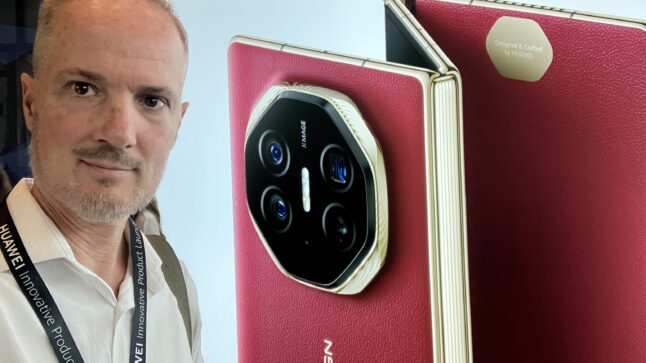I was in Kuala Lumpur for the launch of the new Huawei XT smartphone. That’s their new phone with three screens that unfold into a tablet.
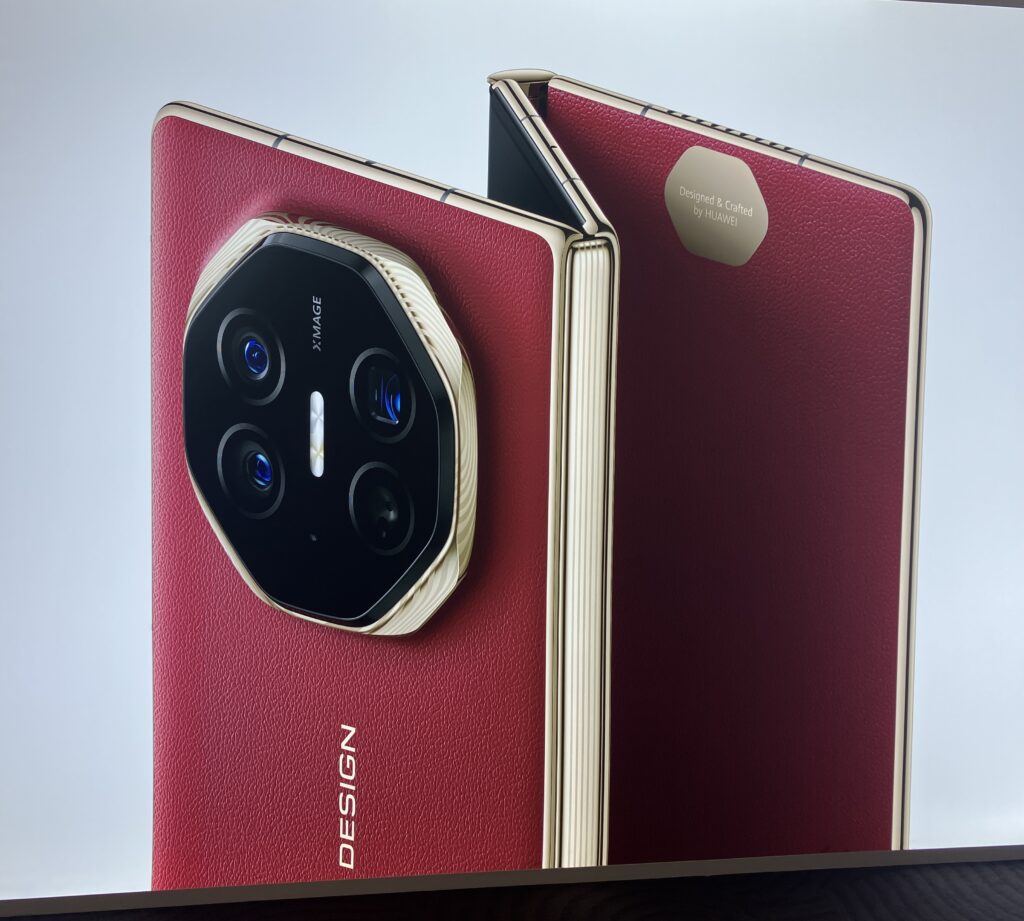
And it was amazing.
And it wasn’t just the trifold. Huawei’s Device Business Group (DBG) also unveiled new watches, tablets and EarPods.
What jumped out at me is that Huawei’s device group is innovating in consumer electronics at a pace we have not seen since Steve Jobs led Apple. They are not doing little incremental innovations, like we have seen from Apple under Tim Cook. They are making one breakthrough innovation after another.
There’s an important innovation question here:
Why is Huawei (despite serious US regulatory action) still out innovating Apple so dramatically?
I’ll go through the innovation side of this shortly, but first let me go through the new products.
The Huawei Mate XT (i.e., Trifold) Is Awesome
I was at the Apple Store in Manhattan at 8am on January 27, 2010. That was when the first iPad was released. I had ordered it weeks before and was lined up that day to pick it up.
But I had no idea what to do with the iPad. It was a completely new form factor. Did you watch movies on it? Was it a small PC? Did you make phone calls with it?
I didn’t’ really care. I just knew I wanted the latest thing by Steve Jobs.
I started playing with the iPad on my way home on the upper West side. And people kept stopping me to take a look. I sat in a Starbucks and everyone was coming over to check it out.
That year, 2010, was arguably peak innovation under Steve Jobs. And the iPad was his latest and last big innovation, after the iPod, iMac and iPhone. We never got Steve’s version of a TV.
That’s how the Huawei product launches felt last week. They were exciting. Some of the products were completely new. They all had new innovations.
And this was nothing new. Huawei also launched 4 new products in 2024. They are aggressively pushing the boundaries of consumer electronics every year.
Playing with the trifold, he first thing that jumped out was, of course, the trifold screen. It’s great. It’s huge. Basically, tablet size. And it’s really cool to be able to carry such a big screen in your pocket.
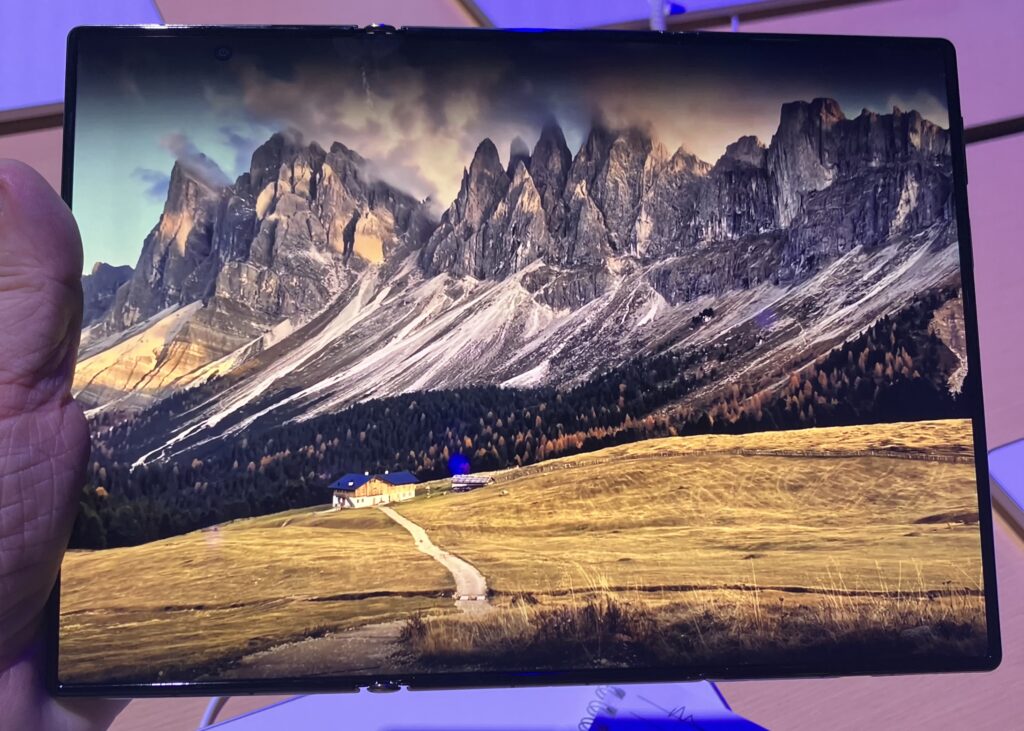
The second thing that jumped out is it is really thin and light. It’s surprisingly thin in your hand. The width is 3.6mm, about the width of a coin. And when you fold it up, it is not very big.
Width is a big problem with a trifold. You are basically putting three phones together. Even each isn’t really thin, it becomes but big and heavy to carry around in a pocket. The XT is shockingly thin. See below.
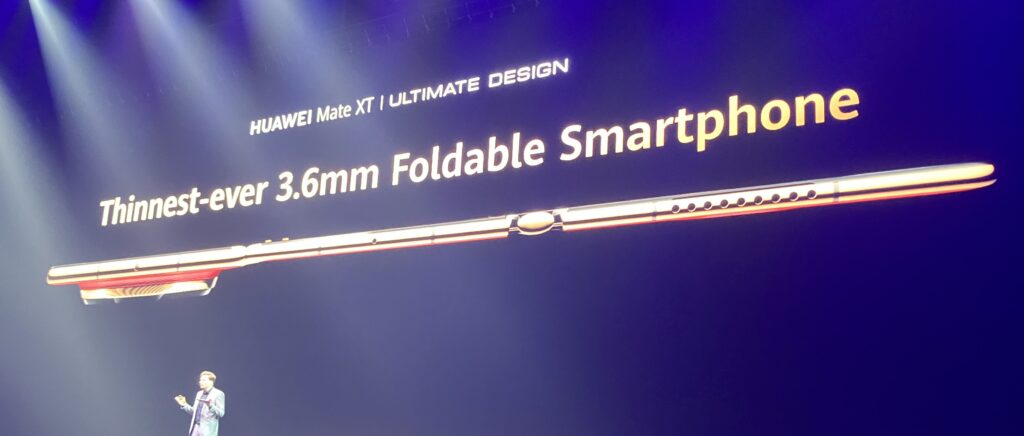

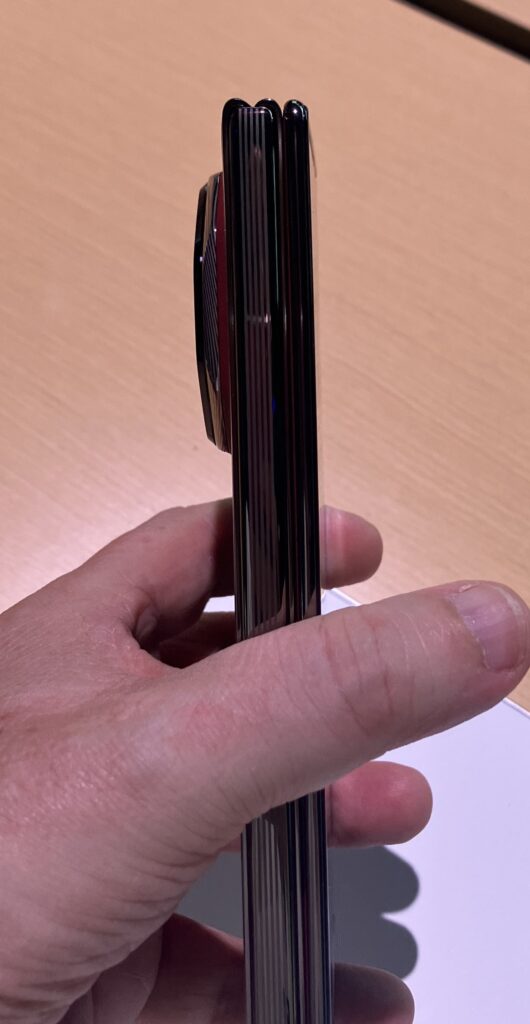
The killer use case is not just the big screen. It’s that it gives you 3 ways to use common functions.
- As a smartphone
- As a folded smartphone (i.e., two screens)
- As a tablet (i.e., three screens)
Here’s the management slides that got my attention.
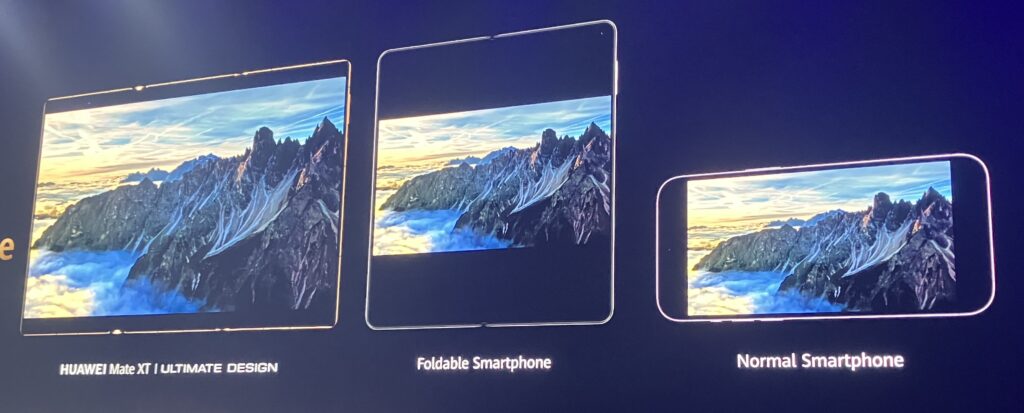
When you think about it, watching videos on a regular smartphone is really bad. It’s like peering through a mail slot. A lot of the success of TikTok is making videos on a phone somewhat more watchable with the vertical format. But overall, staring at a smartphone is a really bad way to watch videos. The Trifold fixes that.
Reading documents and presentations on a smartphone is actually even worse. I do this all the time and it is really unpleasant. You have to zoom in and out on different parts of the pdf or ppt. It’s hard on the eyes. It’s 100% better on the trifold.
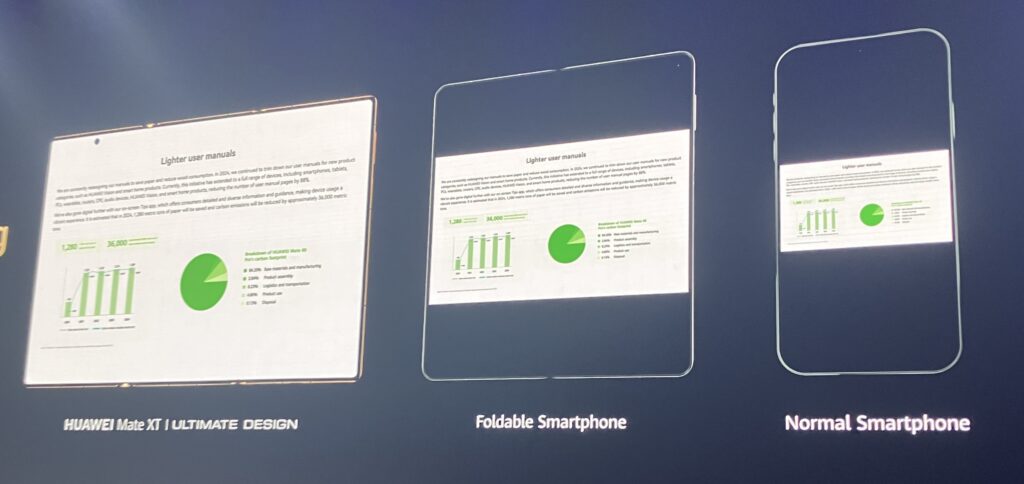
Mapping is surprisingly great in the three configurations. Especially as you’re walking around.
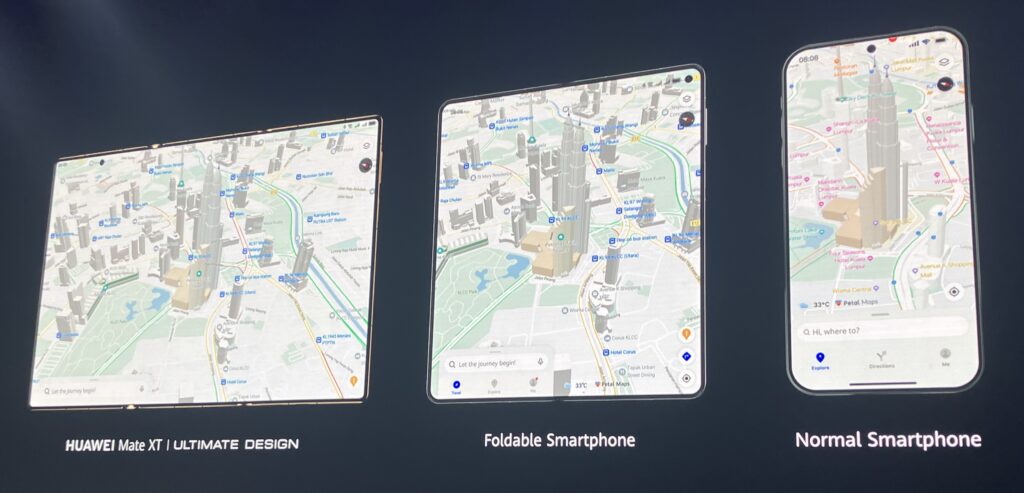
Messenger is also good. But not a game changer.
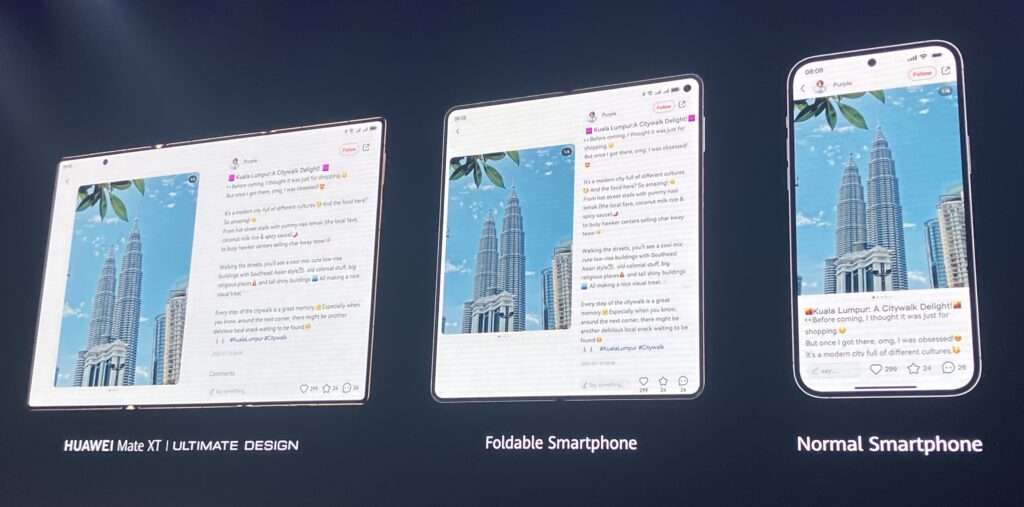
I think the other killer use case is the ability to open 2-3 apps at the same time. And change how you use them on the screen.
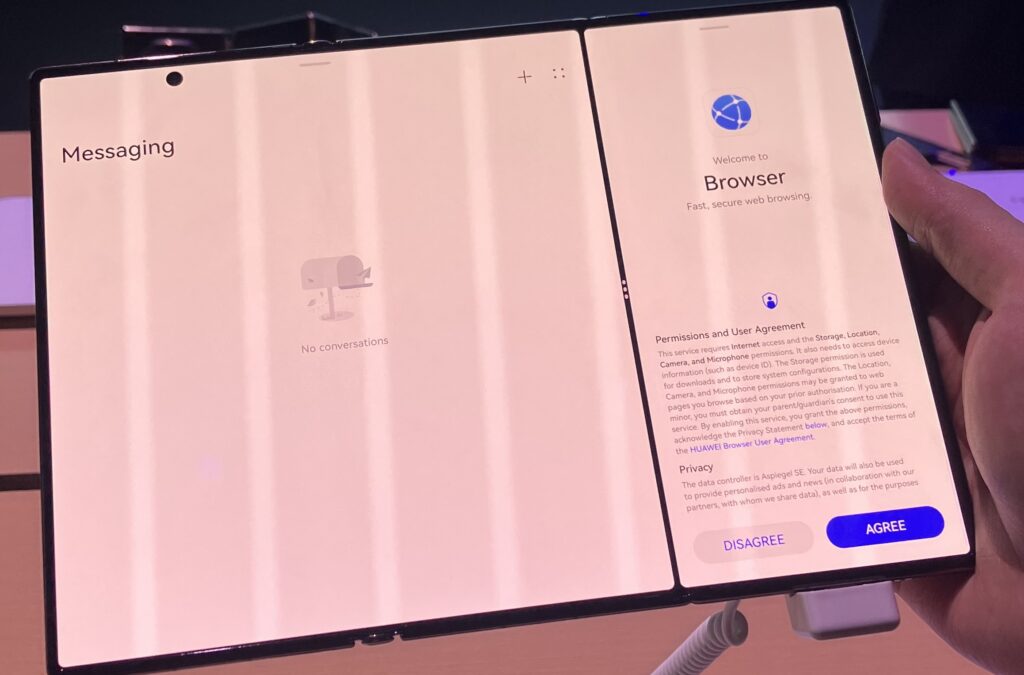
One of Huawei’s big selling points for the XT is the big, powerful camera on the back. Not really my interest but it is one of their big selling points.
The negative is there is no stylus (yet) for the screen. I assume that is what is coming next if they can figure out the tech.
The other negative is the high initial price ($3,500). But that should come down pretty fast. I expect it to end up in the $1500 range (a guess).
Ok. Let’s get into the business thinking here.
4 Types of Innovation
McKinsey & Co cites 4 types of innovation:
- Cost innovation
- Customer facing innovation
- Engineering innovation
- Science innovation
China has long been very good at cost innovation. Making existing products and services cheaper at similar quality. This is actually tricky. It requires a lot of process engineering and workflow improvements.
And this is not to be underestimated. It’s very powerful.
It’s why BYD’s EVs are so cheap (starting at $9,500). It’s why Chinese refrigerators, smartphones and air conditioners are everywhere in the world. And it’s why American consumers love Shein and Temu.
And certainly, Huawei was a cost innovator for the first two decades of its existence. It was exceptional at making quality telecommunications equipment at much cheaper prices, mostly by leveraging manufacturing economies of scale.
For customer facing innovation, I always think of Steve Jobs.
He didn’t invent the laser printer or the Macintosh. He found those inventions and put them together in customer friendly formats. He was great a predicting consumer behavior. And assembling devices that delighted consumers. In fact, much of Silicon Valley is focused on customer facing innovation. There was no new tech at Uber, YouTube or Airbnb.
Over the past 15 years, Huawei has really shifted to engineering innovation. While they have flooded money into R&D since their founding in 1987, they were mostly tech followers until around 2010, focusing on cheaper versions.
But in the last 15 years they have moved from tech follower to tech leader, first in telecommunications. They were a follower for 4G. But they were the leader for 5G.
Engineering innovation is about creating new machines and devices. And when you look at the Huawei headcount, you see an army of engineers. Approximately 114,000 (about 55%) of Huawei’s 207,000 employees work in R&D. And about 70% of their workforce has bachelor’s or above degrees in STEM fields.
Most all of the innovations in their newly released products are about breakthroughs in engineering innovation.
I used to think about Elon Musk for Engineering Innovation. Steve Jobs made consumer devise but Elon could land rocket ships. Increasingly, I am increasingly thinking about Huawei and other Chinese companies for this. There are a lot of great China engineering-based firms going international right now (BYD, DJI, Unitree Robotics, Xpeng).
As for science innovation, that is about advances in chemistry, applied materials, biology, medical science, etc. These are pretty tough areas to make advancements.
Which brings me to Apple vs. Huawei.
How Does Huawei Innovate? They Use Their Hardware and Linked Businesses to Offer Things Rivals Cannot.
What jumps out at me from the new Huawei (and Apple) products is that Huawei is making breakthrough after breakthrough in engineering. And Apple is, at best, doing small incremental innovations.
Think about some recent history:
- Huawei has just launched the Trifold. Something completely new.
- Apple has just launched its iPhone 16. It’s only selling point was a new side button. A couple of new colors. And some AI features that don’t exist yet.
- Huawei also jumped into electric vehicles in 2021. Today, it is a major technology provider in the space. You can see their cars in the Huawei stores across China.
- In contrast, Apple canceled its car project (Project Titan) in 2024 after 10 years of work and billions spent. They never released a car.
- Huawei also jumped into LLMs and GenAI in 2021. They now offer a full GenAI tech stack and a full suite of models (Pangu).
- In contrast, Apple has no LLMs (at least not available externally). They have partnered with OpenAI internationally and with Alibaba in China to incorporate this.
- Apple’s biggest attempt at a breakthrough product was the Apple Vision Pro, its VR headset. That was launched in 2024. It hasn’t been canceled yet but production was scaled back or halted in late 2024.
It’s really hard to ignore the contrast between these two companies, the leading smartphone makers of China and the US.
So how is Huawei doing this? I think the answer is 3 things:
- Huawei has an aggressive and highly innovative tech culture, at large scale. This is a hard charging engineering firm at very large scale (+200,000 staff). Their business is not their products, which all become obsolete quickly. It is their collective brainpower, which is organized by a hard charging culture. You really do not want to compete with them. Even other Chinese firms don’t want to compete with Huawei.
- Huawei leverages their deep expertise in hardware. Most of the new consumer devices are based on hardware breakthroughs, not software. This is a manufacturing plus R&D firm at its core. In contrast, Silicon Valley companies are good at software but weak at hardware (which is outsourced to Asia). Huawei leverage its hardware capabilities in telco, cloud and enterprise businesses.
- Huawei has linked businesses. Consumer electronics is a fairly tough business. There aren’t a lot of competitive advantages. You have to create new stuff and market like crazy every year. Like movies, it’s a hits driven business. This makes it hard to be a stand-alone consumer electronics company (like Xiaomi). Huawei has linked its devices business to its telecommunications, cloud and enterprise businesses, which provide stable cash flow and resources. Disney does the same thing by linking its hits-driven movie business with its stable cash flow theme park business.
I think these are the big
Ok. With that framework, let’s look at the products they just released.
That’s in Part 2.
-jeff
———
Related articles:
- BYD Is Going for Global EV Leadership (1 of 2) (Tech Strategy – Daily Article)
- A Breakdown of the Verisign Business Model (2 of 2) (Tech Strategy – Daily Article)
- 3 Factors Will Determine the Future of Verisign Inc. (Tech Strategy – Podcast 191)
- A Strategy Breakdown of Arm Holdings (1 of 3) (Tech Strategy – Daily Article)
From the Concept Library, concepts for this article are:
- Innovation
- SMILE: Sustained Innovation
From the Company Library, companies for this article are:
- Huawei: Devices Group and HarmonyOS
- Apple
——–
I am a consultant and keynote speaker on how to accelerate growth with improving customer experiences (CX) and digital moats.
I am a partner at TechMoat Consulting, a consulting firm specialized in how to increase growth with improved customer experiences (CX), personalization and other types of customer value. Get in touch here.
I am also author of the Moats and Marathons book series, a framework for building and measuring competitive advantages in digital businesses.
This content (articles, podcasts, website info) is not investment, legal or tax advice. The information and opinions from me and any guests may be incorrect. The numbers and information may be wrong. The views expressed may no longer be relevant or accurate. This is not investment advice. Investing is risky. Do your own research.
